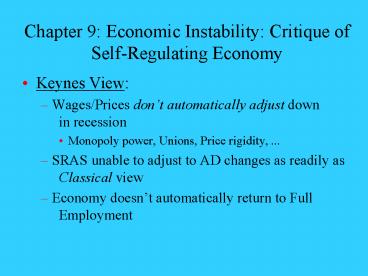Chapter 9: Economic Instability: Critique of SelfRegulating Economy PowerPoint PPT Presentation
1 / 9
Title: Chapter 9: Economic Instability: Critique of SelfRegulating Economy
1
Chapter 9 Economic Instability Critique of
Self-Regulating Economy
- Keynes View
- Wages/Prices dont automatically adjust down in
recession - Monopoly power, Unions, Price rigidity, ...
- SRAS unable to adjust to AD changes as readily as
Classical view - Economy doesnt automatically return to Full
Employment
2
- New Keynesians View
- Competitive markets mean wages prices quickly
adjust to demand/supply changes - Then why dont markets adjust?
- New Keynesians use micro-based reasons for
slowly adjusting prices and wages - Wages adjust slowly due to long-term contracts
- Prices changes costly for firms in short-run
response to demand changes - Efficiency Wage Modelsabove market wages
provide incentive for production and less
shirking
3
- Summarizing (both) Keynesian Views
- Prices/Wages dont freely adjust in recession,
even if surplus of goods/labor/inputs exist - Breakdown or delay in market adjustments
- SRAS unable to adjust to Demand-Side changes in
economy as quickly as Classical view assumes - Fundamentally different view of market
adjustments than Classical school
4
How Long is Adjustment Process when in
Recessionary Gap?
Price Level
LRAS
- Classical View
- Wage/Ps decrease, returning economy to LRAS
- Relatively short time
- Keynesian View
- Short-run adjustment takes long time
- Economy not self-regulating in short-run
- Government intervention may be necessary
SRAS1
SRAS2
- 1
- 2
AD1
- Real GDP
Q1
QNatural
5
Keynes on the Private Sector and Investment
Spending
- Investment spending not always responsive to
lower interest rates - Pessimistic business expectations
- Private sector unable to get economy our of
recessionary gap
6
Classical View of Interest Rate Flexibility in
Credit Market
Interest Rate (i)
- Investment Demand (I1) slopes down
- Lower Interest Rate, lowers cost of borrowing ,
raises Investment - Savings (investment) Supply (S1) slopes up
- Higher Interest Rate, higher reward to saving,
save more - Equilibrium iE and E
S1
iE
I1
- s Save\Invested
E
7
Classical View of Interest Rate Flexibility in
Credit Market (cont.)
Interest Rate (i)
S1
- Reduced C means Increased Supply of Saving lowers
i, raising s Invested - Flexibility of interest rates
- Lower i stimulates investment and AD
S2
- 1
i1
i2
- 2
I1
s Save\Invested
10
12
8
Keyness Criticism of Interest Rate Flexibility
in Credit Market (cont.)
- Investment not always responsive to interest
rates - More responsive to income than interest rate
- Investment responds to expectations, innovations
- Even if interest rate adjusts, saving I may not
- Economy stuck in Recessionary Gap
9
Keynesian View of Great Depression
- Market system not as stable as Classical View
- Keynes focused on determinants of AD
- Private-Sector spending decisions inherently
unstable, especially I-spending - Dont always respond to changes in Ps/interest
rate - Expectations important in dampening recession
and promoting recovery - Pessimistic expectations can magnify economic
downturn - Problem of market coordination

